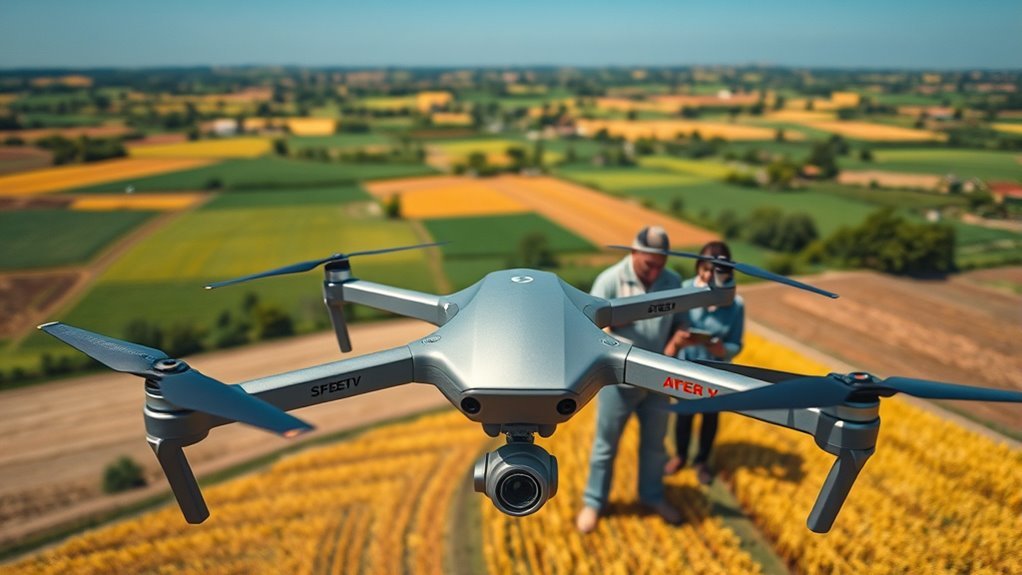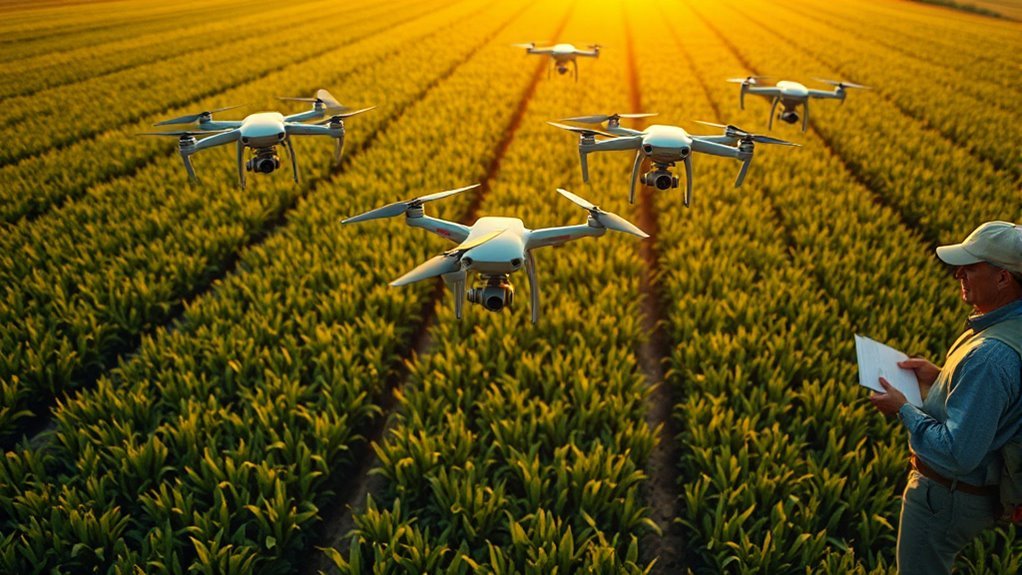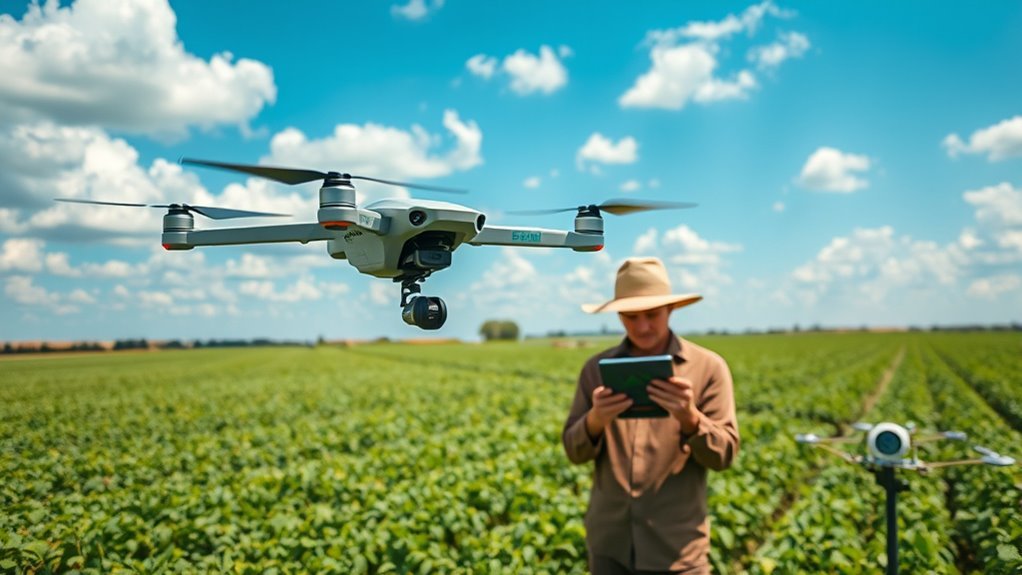When considering the cost of an agricultural drone, you’ll find various factors at play. Drone specifications, camera quality, flight time, and range all greatly impact prices. Payload capacity, software features, and brand reputation also contribute. Furthermore, compliance with regulatory standards and warranty support can influence overall costs. Additionally, think about any necessary accessories or unique features for your needs. Understanding these elements can help you make a more informed purchasing decision and refine your operational strategies.
Drone Specifications

When considering the cost of agricultural drones, the specifications play a crucial role, as they directly impact performance and capabilities. Drone size and drone weight are critical factors influencing both functionality and price. Larger drones typically offer greater payload capacities and coverage areas, allowing for more efficient data collection across expansive fields. However, this size often correlates with increased weight, which can affect flight duration and maneuverability. A heavier drone might require more powerful batteries, leading to higher operational costs. Conversely, smaller, lighter drones may be more agile and suitable for intricate tasks but may lack the endurance needed for larger agricultural operations. Evaluating these specifications guarantees you invest wisely in a drone that meets your farming needs and aspirations. Additionally, understanding advanced geofencing systems can further enhance operational efficiency and safety in agricultural practices. Moreover, the choice between high-resolution imaging and durability can significantly influence the overall cost of the drone.
Camera Quality

Drone specifications are only part of the equation when evaluating agricultural drones; camera quality is equally significant. High camera performance directly influences the effectiveness of your agricultural operations. A drone equipped with a high-resolution camera can capture detailed images, allowing for precise analysis of crop health and field conditions. Image resolution plays an essential role in this process; higher resolution means clearer images, enabling you to identify issues like pests or nutrient deficiencies early. When you’re investing in a drone, consider whether its camera can deliver the clarity and detail you need for informed decision-making. Ultimately, the right camera can enhance your operational efficiency, providing the freedom to manage your agricultural tasks more effectively. Additionally, high-resolution imaging from Delair’s cameras allows for early detection of crop stress, which is crucial for maintaining healthy yields. Furthermore, employing high-precision sensors ensures that you achieve consistent, professional-grade results, elevating the overall quality of your agricultural assessments.
Flight Time and Range

Although many factors influence the efficiency of agricultural drones, flight time and range are critical for maximizing productivity in the field. You need to evaluate how long your drone can operate on a single battery charge and the distance it can cover before needing to return. Advances in battery technology have greatly improved flight efficiency, allowing for longer operational periods without compromising performance. A drone with extended flight time can complete larger areas in one go, reducing the need for frequent recharges and increasing overall efficiency. Additionally, understanding the interplay between battery capacity and the drone’s weight can help you select the right model for your specific agricultural needs, ensuring you get the most out of your investment. Furthermore, NDAA compliance is an important consideration for ensuring your drone meets necessary security standards while operating in sensitive environments. For example, the Wingtra One’s superior endurance allows for seamless mission shifts, enhancing productivity in demanding scenarios.
Payload Capacity
Understanding the flight time and range of agricultural drones naturally leads to contemplating their payload capacity, which plays a significant role in operational efficacy. A drone’s payload capacity directly influences its ability to carry essential equipment like sensors, fertilizers, or pesticides. To maximize productivity, you’ll want to focus on payload optimization. This involves not just the total weight but also weight distribution, guaranteeing that the drone maintains stability during flight. An unbalanced load can drastically reduce efficiency and flight time. By strategically planning the payload, you can enhance operational flexibility, allowing for varied applications across different agricultural environments. Additionally, real-time data from drones can inform decisions on optimal payloads, ensuring that resources are used efficiently. Ultimately, effective payload management guarantees you harness the full potential of your agricultural drone while minimizing costs, especially as market dynamics shift due to potential disruptions in the industry.
Software and Data Analytics
As agricultural technology evolves, the importance of software and data analytics in maximizing drone operations becomes increasingly evident. You’ll find that effective data visualization tools allow you to interpret complex data sets quickly, enabling informed decision-making. By leveraging predictive analytics, you can forecast crop yields, pest infestations, and ideal planting times, ultimately enhancing productivity and resource management. The integration of these advanced systems not only streamlines your operations but also reduces costs over time. Furthermore, the ability to analyze real-time data helps you respond dynamically to changing agricultural conditions. In this landscape, investing in quality software is essential, as it directly impacts how successfully you harness the full potential of your agricultural drones. Moreover, advanced analytics can help identify inefficiencies, empowering you to allocate resources more effectively and anticipate challenges proactively. Additionally, the integration of AI solutions within your software can enhance precision and reliability in your data processing capabilities.
Customization Options
When considering customization options for agricultural drones, you’ll want to examine both software features and hardware specifications. The included software capabilities can greatly enhance data collection and analysis, impacting overall efficiency. Additionally, variability in hardware specifications allows you to tailor the drone to specific agricultural needs, influencing both performance and cost. Furthermore, incorporating multispectral cameras can significantly improve crop health monitoring and resource allocation. This is further supported by real-time data collection, which allows for instant insights that can transform monitoring efforts.
Software Features Included
While many agricultural drones come equipped with standard software features, the level of customization available can greatly impact their overall cost. When evaluating different models, consider how the user interface aligns with your specific needs. A highly customizable user experience allows you to tailor functionalities such as mapping, data analysis, and flight patterns. This flexibility not only enhances operational efficiency but can also lead to better crop management outcomes. You might find that investing in advanced software options, like real-time analytics or integration with existing farm management systems, pays off in the long run. Ultimately, the right software features enable you to optimize your drone’s capabilities, translating to improved productivity and profitability in your agricultural endeavors.
Hardware Specifications Variability
Given that agricultural drone performance heavily relies on hardware specifications, the variability in customization options can greatly influence costs. When you consider the range of hardware components—motors, batteries, and frames—each choice impacts your drone’s overall hardware performance. For instance, opting for high-capacity batteries enhances flight duration but raises the price. Similarly, the integration of advanced sensors for data collection can notably improve crop monitoring capabilities yet adds to the cost. Understanding these customization options allows you to tailor your drone to specific agricultural needs while balancing performance and budget. Ultimately, knowing how different hardware elements affect both efficiency and expenses empowers you to make informed decisions that align with your operational goals.
Brand Reputation
Brand reputation plays an essential role in determining the costs associated with agricultural drones. When you consider a brand’s standing in the market, you’re not just looking at its products but also at the trust it builds with consumers. High brand loyalty often translates into higher prices because customers perceive these drones as more reliable and effective. This market perception greatly influences your purchasing decisions; if a brand is well-regarded for quality and service, you’re likely willing to invest more. Additionally, established brands often benefit from economies of scale, which can help maintain competitive pricing despite their premium positioning. Ultimately, understanding brand reputation can guide you in making informed choices that align with your agricultural needs and budget. Furthermore, drones with advanced obstacle avoidance systems can significantly enhance operational efficiency and safety, further justifying their higher price points. This focus on research and development commitment allows leading brands to continuously innovate, providing consumers with cutting-edge technology that enhances their agricultural operations.
Regulatory Compliance
Understanding regulatory compliance is essential when considering agricultural drone costs, as it directly impacts both the price and functionality of the equipment. You’ll need to stay updated on regulatory changes that can affect how you operate your drone. Compliance challenges can arise from varying local laws, airspace restrictions, and operational guidelines. These factors not only influence the cost of your drone but also determine its capabilities and permissible uses. Investing in drones that meet regulatory standards may initially seem pricier, yet it can save you from potential fines and operational setbacks. By prioritizing compliance, you guarantee that your drone serves its purpose efficiently while maintaining your freedom to operate without legal hindrances. Additionally, understanding the FAA regulations is crucial since they impose operational limits that can affect your drone’s functionality and integration into the airspace. Moreover, ensuring NDAA compliance can enhance your drone’s appeal, particularly for government and military applications, providing further justification for the investment.
Warranty and Support
While you may focus primarily on the initial purchase price of agricultural drones, warranty and support can greatly affect long-term costs and operational efficiency. Understanding warranty terms is important; they dictate how long you’ll receive coverage for repairs or replacements, greatly impacting your budget. A solid warranty can save you from unexpected expenses down the road. Additionally, the availability of support services is essential. If you encounter technical issues, responsive support can minimize downtime and enhance productivity. It’s crucial to choose a manufacturer that offers thorough support, ensuring you can maximize your drone’s capabilities. Ultimately, the right warranty and support can lead to smoother operations, freeing you to focus on optimizing your agricultural practices without constant worry about potential costs.
Additional Accessories and Features
When evaluating agricultural drones, the additional accessories and features greatly impact the overall cost. Advanced sensor options, data processing software, and customizable payload capacity can enhance your drone’s capabilities, but they also increase your investment. Understanding these components is essential for making informed decisions that align with your operational needs.
Advanced Sensor Options
As agricultural technology evolves, integrating advanced sensor options into drones can greatly enhance their functionality and data collection capabilities. These sensors improve data accuracy considerably, allowing for informed decision-making in farming practices. Here’s a quick overview of common sensor types you might consider:
| Sensor Type | Purpose |
|---|---|
| Multispectral | Crop health assessment |
| Thermal | Irrigation management |
| LiDAR | Topographic mapping |
Data Processing Software
Although selecting the right drone hardware is essential, the effectiveness of agricultural drones relies heavily on the quality of data processing software. This software not only enhances operational efficiency but also provides critical insights through data integration. Here are three key features to contemplate:
- Real-time Data Analytics: Allows for immediate decision-making based on current crop conditions.
- Predictive Analytics Trends: Helps anticipate future agricultural needs and challenges, driving proactive measures.
- User-friendly Interface: Simplifies the data interpretation process, making it accessible for all operators.
Investing in robust data processing software can greatly elevate your drone’s performance, ensuring you stay ahead in an ever-evolving agricultural landscape.
Customizable Payload Capacity
A diverse range of customizable payload capacities can greatly enhance your agricultural drone’s versatility and functionality. By allowing for payload adjustment, you can tailor your drone for specific tasks, whether it’s spraying fertilizers or carrying sensors. Adding components like additional tanks or specialized attachments can considerably improve efficiency and precision in your operations.
Moreover, understanding weight distribution is vital; balancing your payload guarantees ideal flight performance and extends battery life. Each accessory or feature you choose should align with your operational goals, maximizing the drone’s capabilities while maintaining stability. This flexible approach not only empowers you to tackle diverse agricultural challenges but also enhances the overall return on your investment, making customizable payload capacity a key factor in drone costs.
Frequently Asked Questions
How Do Seasonal Trends Affect Agricultural Drone Prices?
Imagine the fields changing colors; as seasons shift, so does demand for agricultural drones. High seasonal demand leads to price fluctuations, impacting your budget. Understanding these trends helps you make informed purchasing decisions for peak efficiency.
Are There Financing Options Available for Purchasing Agricultural Drones?
Yes, there’re financing options available for purchasing agricultural drones, including drone loans specifically designed for farmers. These loans can help you manage costs effectively, ensuring you invest in technology without overwhelming your budget.
What Are the Maintenance Costs Associated With Agricultural Drones?
If you think drones don’t need upkeep, think again! Maintenance frequency varies, but neglecting it can lead to hefty repair costs. Regular check-ups are essential to keep your agricultural drone flying smoothly and efficiently.
How Do Regional Regulations Impact Drone Pricing?
Regional regulations greatly impact drone pricing. You’ll face licensing requirements and compliance costs, which can vary widely. Understanding these factors helps you budget effectively and navigate the complexities of operating within different jurisdictions.
Can Used Agricultural Drones Be a Cost-Effective Option?
Think of buying a used agricultural drone as planting seeds for financial growth. You’ll enjoy used drone benefits, reaping second-hand savings while still accessing advanced technology, ultimately enhancing your farming efficiency without breaking the bank.

